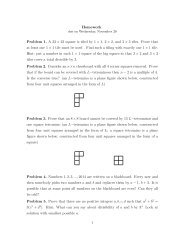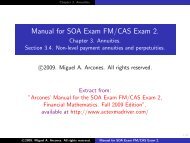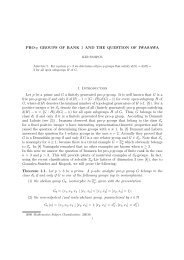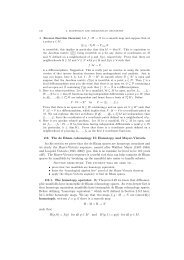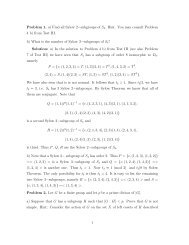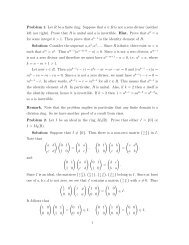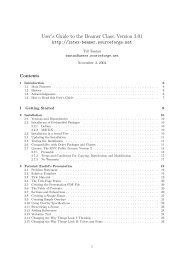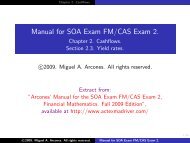Manual for SOA Exam MLC.
Manual for SOA Exam MLC.
Manual for SOA Exam MLC.
You also want an ePaper? Increase the reach of your titles
YUMPU automatically turns print PDFs into web optimized ePapers that Google loves.
Chapter 3. Life tables.<br />
<strong>Manual</strong> <strong>for</strong> <strong>SOA</strong> <strong>Exam</strong> <strong>MLC</strong>.<br />
Chapter 3. Life tables.<br />
Section 3.3. Continuous computations.<br />
c○2008. Miguel A. Arcones. All rights reserved.<br />
Extract from:<br />
”Arcones’ <strong>Manual</strong> <strong>for</strong> <strong>SOA</strong> <strong>Exam</strong> <strong>MLC</strong>. Fall 2009 Edition”,<br />
available at http://www.actexmadriver.com/<br />
c○2008. Miguel A. Arcones. All rights reserved. <strong>Manual</strong> <strong>for</strong> <strong>SOA</strong> <strong>Exam</strong> <strong>MLC</strong>.<br />
1/15
Continuous computations<br />
Chapter 3. Life tables. Section 3.3. Continuous computations.<br />
Although, a life table does not show values of ℓx <strong>for</strong> non integers<br />
numbers, we will assume that ℓx is known <strong>for</strong> each x ≥ 0. In the<br />
next section, we will discuss how to estimate ℓx <strong>for</strong> non integers.<br />
Knowing ℓx, <strong>for</strong> each x ≥ 0, we can get<br />
s(x) = ℓx<br />
,<br />
ℓ0<br />
µ(x) = − d<br />
dx (log(ℓx)) = − ℓ′ x<br />
,<br />
� ∞<br />
◦ ℓx<br />
e0 =<br />
0 ℓ0<br />
� ∞<br />
◦ ℓx+t<br />
ex =<br />
0 ℓx<br />
dx,<br />
dt.<br />
c○2008. Miguel A. Arcones. All rights reserved. <strong>Manual</strong> <strong>for</strong> <strong>SOA</strong> <strong>Exam</strong> <strong>MLC</strong>.<br />
ℓx<br />
2/15
Definition 1<br />
Chapter 3. Life tables. Section 3.3. Continuous computations.<br />
Tx is the expected number of years lived beyond age x by the<br />
cohort group with l0 members.<br />
Theorem 1<br />
(i) Tx = � ∞<br />
(ii)<br />
0 ℓx+t dt and ◦ ex = E[T (x)] = Tx<br />
ℓx .<br />
E[(T (x)) 2 ] = 2 � ∞<br />
x Ty dy<br />
Notice that the expected number of years lived beyond age x by an<br />
individual alive at age x is ◦ ex. The expected number of individuals<br />
◦<br />
alive at age x is ℓx. Hence, Tx = ℓxex.<br />
c○2008. Miguel A. Arcones. All rights reserved. <strong>Manual</strong> <strong>for</strong> <strong>SOA</strong> <strong>Exam</strong> <strong>MLC</strong>.<br />
ℓx<br />
.<br />
3/15
Proof.<br />
(i) We have that<br />
Chapter 3. Life tables. Section 3.3. Continuous computations.<br />
Tx = ℓ0E[(X − x)I (X > x)] = ℓ0P{X > x}E[X − x|X > x]<br />
=ℓxE[T (x)] = ℓx<br />
� ∞<br />
0<br />
tpx dt =<br />
� ∞<br />
ℓx+t dt.<br />
0<br />
(ii) Using that Tx = � ∞<br />
0 ℓx+t dt = � ∞<br />
x ℓt dt, we get that<br />
So,<br />
2<br />
=2<br />
� ∞<br />
x<br />
� ∞<br />
x<br />
Ty dy = 2<br />
� ∞ � ∞<br />
x<br />
(t − x)ℓt dt = 2<br />
2 � ∞<br />
x Ty dy<br />
ℓx<br />
=<br />
� ∞<br />
0<br />
ℓt dt dy = 2<br />
y<br />
� ∞<br />
uℓx+u du.<br />
0<br />
� ∞ � t<br />
2u · upx du = E[(T (x)) 2 ].<br />
c○2008. Miguel A. Arcones. All rights reserved. <strong>Manual</strong> <strong>for</strong> <strong>SOA</strong> <strong>Exam</strong> <strong>MLC</strong>.<br />
x<br />
x<br />
ℓt dy dt<br />
4/15
<strong>Exam</strong>ple 1 �<br />
Suppose ℓx = ℓ0<br />
Chapter 3. Life tables. Section 3.3. Continuous computations.<br />
1 − x2<br />
ω 2<br />
and Var(T (x)) using Theorem 1.<br />
�<br />
, <strong>for</strong> 0 ≤ x ≤ ω. Find ◦ ex, E[(T (x)) 2 ]<br />
c○2008. Miguel A. Arcones. All rights reserved. <strong>Manual</strong> <strong>for</strong> <strong>SOA</strong> <strong>Exam</strong> <strong>MLC</strong>.<br />
5/15
<strong>Exam</strong>ple 1 �<br />
Suppose ℓx = ℓ0<br />
Chapter 3. Life tables. Section 3.3. Continuous computations.<br />
1 − x2<br />
ω 2<br />
and Var(T (x)) using Theorem 1.<br />
Solution:<br />
We have that<br />
� ∞ � ω−x<br />
Tx = ℓx+t dt =<br />
0<br />
�<br />
, <strong>for</strong> 0 ≤ x ≤ ω. Find ◦ ex, E[(T (x)) 2 ]<br />
ℓ0<br />
0<br />
ω−x<br />
�<br />
1 −<br />
�<br />
(x + t)2<br />
dt<br />
�<br />
3ω2t − (x + t) 3<br />
=ℓ0<br />
3ω2 � � �<br />
��� 3ω2 (ω − x) − ω3 + x 3<br />
= ℓ0<br />
0<br />
3ω2 �<br />
=<br />
� �<br />
2ω3 − 3ω2x + x 3<br />
=ℓ0<br />
, 0 ≤ x ≤ ω<br />
Hence,<br />
◦<br />
ex = Tx<br />
ℓx<br />
3ω 2<br />
= 2ω3 − 3ω 2 x + x 3<br />
3(ω 2 − x 2 )<br />
ω 2<br />
= 2ω2 − ωx − x 2<br />
3(ω + x)<br />
c○2008. Miguel A. Arcones. All rights reserved. <strong>Manual</strong> <strong>for</strong> <strong>SOA</strong> <strong>Exam</strong> <strong>MLC</strong>.<br />
= (ω − x)(2ω + x)<br />
.<br />
3(ω + x)<br />
6/15
<strong>Exam</strong>ple 1 �<br />
Suppose ℓx = ℓ0<br />
Chapter 3. Life tables. Section 3.3. Continuous computations.<br />
1 − x2<br />
ω 2<br />
and Var(T (x)) using Theorem 1.<br />
�<br />
, <strong>for</strong> 0 ≤ x ≤ ω. Find ◦ ex, E[(T (x)) 2 ]<br />
Solution:<br />
We also have that<br />
� ∞ � ω �<br />
2ω3 − 3ω2y + y 3<br />
Ty dy = ℓ0<br />
x<br />
x<br />
3ω2 �<br />
dy<br />
�<br />
8ω3y − 6ω2y 2 + y 4<br />
=<br />
12ω2 � �<br />
��� ω<br />
x<br />
= 8ω4 − 6ω4 + ω4 − 8ω3x + 6ω2x 2 − x 4<br />
12ω2 = 3ω4 − 8ω3x + 6ω2x 2 − x 4<br />
12ω2 .<br />
c○2008. Miguel A. Arcones. All rights reserved. <strong>Manual</strong> <strong>for</strong> <strong>SOA</strong> <strong>Exam</strong> <strong>MLC</strong>.<br />
7/15
<strong>Exam</strong>ple 1 �<br />
Suppose ℓx = ℓ0<br />
Chapter 3. Life tables. Section 3.3. Continuous computations.<br />
1 − x2<br />
ω 2<br />
and Var(T (x)) using Theorem 1.<br />
Solution:<br />
E[(T (x)) 2 ] = 2 � ∞<br />
x Ty dy<br />
�<br />
, <strong>for</strong> 0 ≤ x ≤ ω. Find ◦ ex, E[(T (x)) 2 ]<br />
ℓx<br />
= 3ω4 − 8ω 3 x + 6ω 2 x 2 − x 4<br />
6(ω 2 − x 2 )<br />
= 3ω3 − 5ω2x + ωx 2 + x 3<br />
=<br />
6(ω + x)<br />
(ω − x)2 (3ω + x)<br />
,<br />
6(ω + x)<br />
Var(T (x)) = (ω − x)2 �<br />
(3ω + x) (ω − x)(2ω + x)<br />
−<br />
6(ω + x)<br />
3(ω + x)<br />
= (ω − x)2<br />
18(ω + x) 2<br />
� 2<br />
3(ω + x)(3ω + x) − 2(2ω + x) �<br />
= (ω − x)2<br />
18(ω + x) 2<br />
� 2 2<br />
ω + 4ωx + x � .<br />
c○2008. Miguel A. Arcones. All rights reserved. <strong>Manual</strong> <strong>for</strong> <strong>SOA</strong> <strong>Exam</strong> <strong>MLC</strong>.<br />
� 2<br />
8/15
Definition 2<br />
Chapter 3. Life tables. Section 3.3. Continuous computations.<br />
nLx is the expected number of years lived between age x and<br />
age x + n by the ℓx survivors at age x.<br />
Theorem 2<br />
◦<br />
nLx = Tx − Tx+n = ℓxe<br />
x:n| =<br />
� n<br />
ℓx+t dt.<br />
0<br />
c○2008. Miguel A. Arcones. All rights reserved. <strong>Manual</strong> <strong>for</strong> <strong>SOA</strong> <strong>Exam</strong> <strong>MLC</strong>.<br />
9/15
Definition 2<br />
Chapter 3. Life tables. Section 3.3. Continuous computations.<br />
nLx is the expected number of years lived between age x and<br />
age x + n by the ℓx survivors at age x.<br />
Theorem 2<br />
◦<br />
nLx = Tx − Tx+n = ℓxe<br />
x:n| =<br />
� n<br />
ℓx+t dt.<br />
0<br />
Proof: (i) Since the deceased at age x do not live between age x<br />
and age x + n, nLx is the expected number of years lived between<br />
age x and age x + n by the initial ℓ0 lives. So,<br />
nLx = Tx − Tx+n.<br />
c○2008. Miguel A. Arcones. All rights reserved. <strong>Manual</strong> <strong>for</strong> <strong>SOA</strong> <strong>Exam</strong> <strong>MLC</strong>.<br />
10/15
Definition 2<br />
Chapter 3. Life tables. Section 3.3. Continuous computations.<br />
nLx is the expected number of years lived between age x and<br />
age x + n by the ℓx survivors at age x.<br />
Theorem 2<br />
◦<br />
nLx = Tx − Tx+n = ℓxe<br />
x:n| =<br />
� n<br />
ℓx+t dt.<br />
0<br />
Proof: (i) Since the deceased at age x do not live between age x<br />
and age x + n, nLx is the expected number of years lived between<br />
age x and age x + n by the initial ℓ0 lives. So,<br />
nLx = Tx − Tx+n.<br />
(ii) Since ◦ e x:n| is the expected number of years lived between age x<br />
and age x + n by a live aged x,<br />
◦<br />
nLx = ℓxe<br />
x:n|.<br />
c○2008. Miguel A. Arcones. All rights reserved. <strong>Manual</strong> <strong>for</strong> <strong>SOA</strong> <strong>Exam</strong> <strong>MLC</strong>.<br />
11/15
Definition 2<br />
Chapter 3. Life tables. Section 3.3. Continuous computations.<br />
nLx is the expected number of years lived between age x and<br />
age x + n by the ℓx survivors at age x.<br />
Theorem 2<br />
◦<br />
nLx = Tx − Tx+n = ℓxe<br />
x:n| =<br />
� n<br />
ℓx+t dt.<br />
0<br />
Proof: (i) Since the deceased at age x do not live between age x<br />
and age x + n, nLx is the expected number of years lived between<br />
age x and age x + n by the initial ℓ0 lives. So,<br />
nLx = Tx − Tx+n.<br />
(ii) Since ◦ e x:n| is the expected number of years lived between age x<br />
and age x + n by a live aged x,<br />
◦<br />
nLx = ℓxe<br />
x:n|.<br />
◦ � n<br />
(iii) ℓxe<br />
x:n| = ℓx 0 tpx dt = � n<br />
0 ℓx+t dt.<br />
c○2008. Miguel A. Arcones. All rights reserved. <strong>Manual</strong> <strong>for</strong> <strong>SOA</strong> <strong>Exam</strong> <strong>MLC</strong>.<br />
12/15
Chapter 3. Life tables. Section 3.3. Continuous computations.<br />
We will abbreviate Lx = 1Lx, i.e. Lx = � 1<br />
0 ℓx+t dt is the expected<br />
number of years lived between age x and age x + 1 by the ℓx<br />
survivors at age x. Previous equation display implies that<br />
Lx =<br />
� 1<br />
0<br />
ℓx+t dt = Tx − Tx+1.<br />
c○2008. Miguel A. Arcones. All rights reserved. <strong>Manual</strong> <strong>for</strong> <strong>SOA</strong> <strong>Exam</strong> <strong>MLC</strong>.<br />
13/15
Corollary 1<br />
(i) Tx = �∞ (ii) ◦ ex =<br />
(iii) ◦ e x:n| =<br />
k=x Lk.<br />
P∞ k=x Lk<br />
. ℓx Px+n−1 k=x<br />
Lk<br />
ℓx<br />
Chapter 3. Life tables. Section 3.3. Continuous computations.<br />
.<br />
c○2008. Miguel A. Arcones. All rights reserved. <strong>Manual</strong> <strong>for</strong> <strong>SOA</strong> <strong>Exam</strong> <strong>MLC</strong>.<br />
14/15
Corollary 1<br />
(i) Tx = �∞ (ii) ◦ ex =<br />
(iii) ◦ ex:n| =<br />
Proof:<br />
(i)<br />
=<br />
Tx =<br />
k=x Lk.<br />
P∞ k=x Lk<br />
. ℓx Px+n−1 k=x<br />
Lk<br />
ℓx<br />
� ∞<br />
0<br />
∞�<br />
Lk.<br />
k=x<br />
(ii) ◦ ex = Tx<br />
ℓx =<br />
(iii)<br />
◦<br />
ex =<br />
� n<br />
0 ℓx+t dt<br />
ℓx<br />
Chapter 3. Life tables. Section 3.3. Continuous computations.<br />
.<br />
ℓx+t dt =<br />
P ∞<br />
k=x Lk<br />
ℓx<br />
=<br />
� ∞<br />
.<br />
x<br />
� x+n<br />
x<br />
ℓt dt<br />
ℓx<br />
ℓt dt =<br />
=<br />
∞�<br />
k=x<br />
� k+1<br />
k<br />
� x+n−1<br />
k=x<br />
ℓt dt =<br />
� k+1<br />
k<br />
ℓt dt<br />
c○2008. Miguel A. Arcones. All rights reserved. <strong>Manual</strong> <strong>for</strong> <strong>SOA</strong> <strong>Exam</strong> <strong>MLC</strong>.<br />
ℓx<br />
∞�<br />
� 1<br />
ℓk+t dt<br />
k=x<br />
0<br />
=<br />
� x+n−1<br />
k=x<br />
ℓx<br />
Lk<br />
.<br />
15/15



